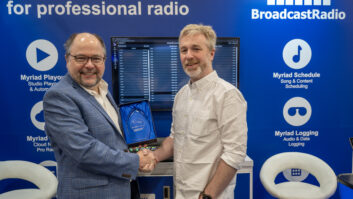The author is senior product marketing manager at Audinate.
An ongoing challenge for stations is maintaining and growing market share. People are consuming content in a variety of formats that best suit their viewing and listening preferences. From traditional AM/FM to satellite to podcast recordings of morning shows, listeners want more options to stay engaged with their favorite stations and on-air talent.

Many stations have added audio livestreaming to their content offering, and more are adopting video livestreaming as a way to expand promotional opportunities for their station and talent. It doesn’t have to be just the top-end stations with the biggest budgets. Livestreaming is more achievable than ever, as high-quality production equipment is becoming increasingly affordable and easier to integrate.
One of the greatest benefits is the ability to reach a larger audience. FM and satellite broadcasts are limited by transmission distance, geography, atmospheric conditions and more. Livestreaming can reach listeners thousands of miles away; all they need is a stable internet connection.
With increased audience, the station’s marketing team has more opportunity to secure larger advertisers and increase revenue. They can promote on-air talent, helping increase listener loyalty. Video clips of interviews or other memorable moments can be posted to social platforms to increase brand awareness and retention. The new livestreaming capabilities can also benefit multiple shows and stations if they share studio space.
Here’s what it takes to add a video livestream capability to a radio studio setup and some technical issues to consider.
[Visit Radio World’s News and Business Page]
Infrastructure needs
If the radio station has deployed an audio-over-IP solution in the studio, adding a video element to the livestream is straightforward. The key is to keep the audio and video synchronized at all times. If the audio-over-IP solution offers native video synchronization, such as Dante AV, adding video livestreaming simply comes down to adding necessary hardware.
If the studio doesn’t have an AV-over-IP solution in place or uses older point-to-point connectivity, the station has a blank-slate opportunity to add an IP-based solution for maximum flexibility. In fact, existing cabling can be used because there are lots of hardware options available to convert from one format to another, saving money.
A computer will be needed in the booth to transcode the AV signal in real time into a format suitable for the livestreaming service. For multi-camera operations, a video switcher is required to allow someone to choose which camera is active at a given time or to display multiple cameras simultaneously, such as with a split screen. There are many switcher options available; the selection should be based partly on compatibility with the chosen AV-over-IP solution and the number of endpoints involved.
Cameras and lighting
The biggest determining factor for choosing video equipment is the space available in the studio, for lights as well as cameras.
Camera placement and focal length are related, and you must account for on-air talent moving around. Granted, movement will be limited by having to stay close to the microphone, but they may move around or lean back when not speaking.
Cameras can range from hundreds to thousands of dollars depending on the application, with a variety in form factor. LED lights are available in a multitude of form factors; the most flexible can switch between “color temperatures” or Kelvin values. Trial and error can determine the best placement and color temperature for each studio.
Most livestream services will either transcode to 1080p automatically to save on bandwidth, or the video compression on a 4K signal may be severe enough to make a higher-end camera not worth the investment. Multiple cameras can increase production value and viewer interest and may be required for shows with multiple hosts or occasional in-studio guests, so make sure to factor that into budget considerations.
More options = audience retention
If the cameras are fixed-angle, the show’s producer should be able to handle the video needs for the livestream. Presets could be set up in the system so that if audio is detected on a specific microphone, the video feed automatically switches to the camera that’s focused on the person speaking into that particular microphone. If more than one mic is active, the feed could switch to a wider-angle fixed camera covering multiple people.
If there’s space in the studio for camera operators, and if the budget can support it, one or two additional team members could be used to operate the cameras. Video switching between multiple cameras can still be straightforward as long as the audio and video feeds are synchronized.
Giving listeners more ways to listen to a station and connect with on-air talent is a great way to keep the audience engaged. The greater the engagement, the greater the promotional and advertising opportunities available to the radio station. The increased revenue and market share retention will quickly surpass the cost of adding a few pieces of AV equipment. \







